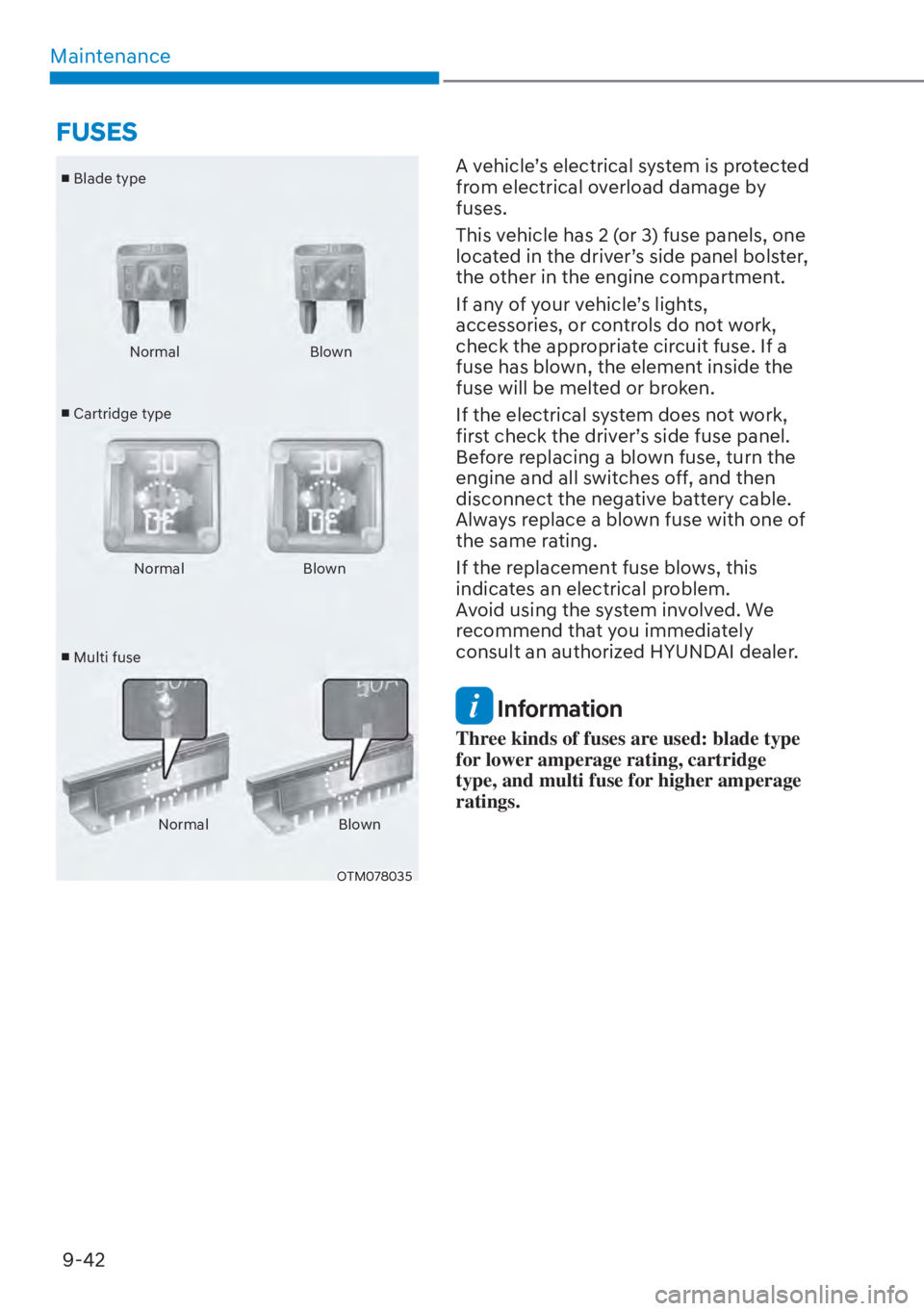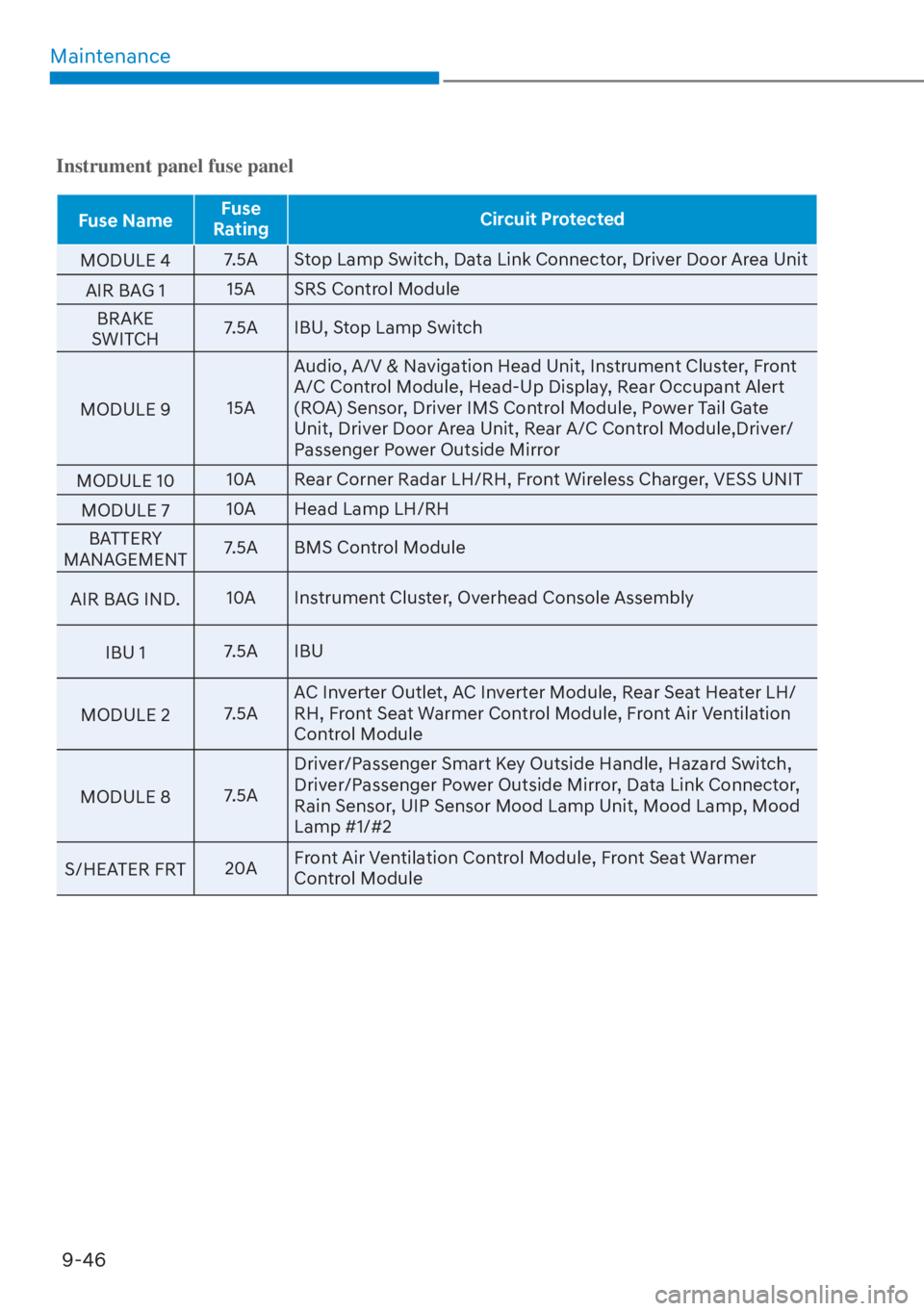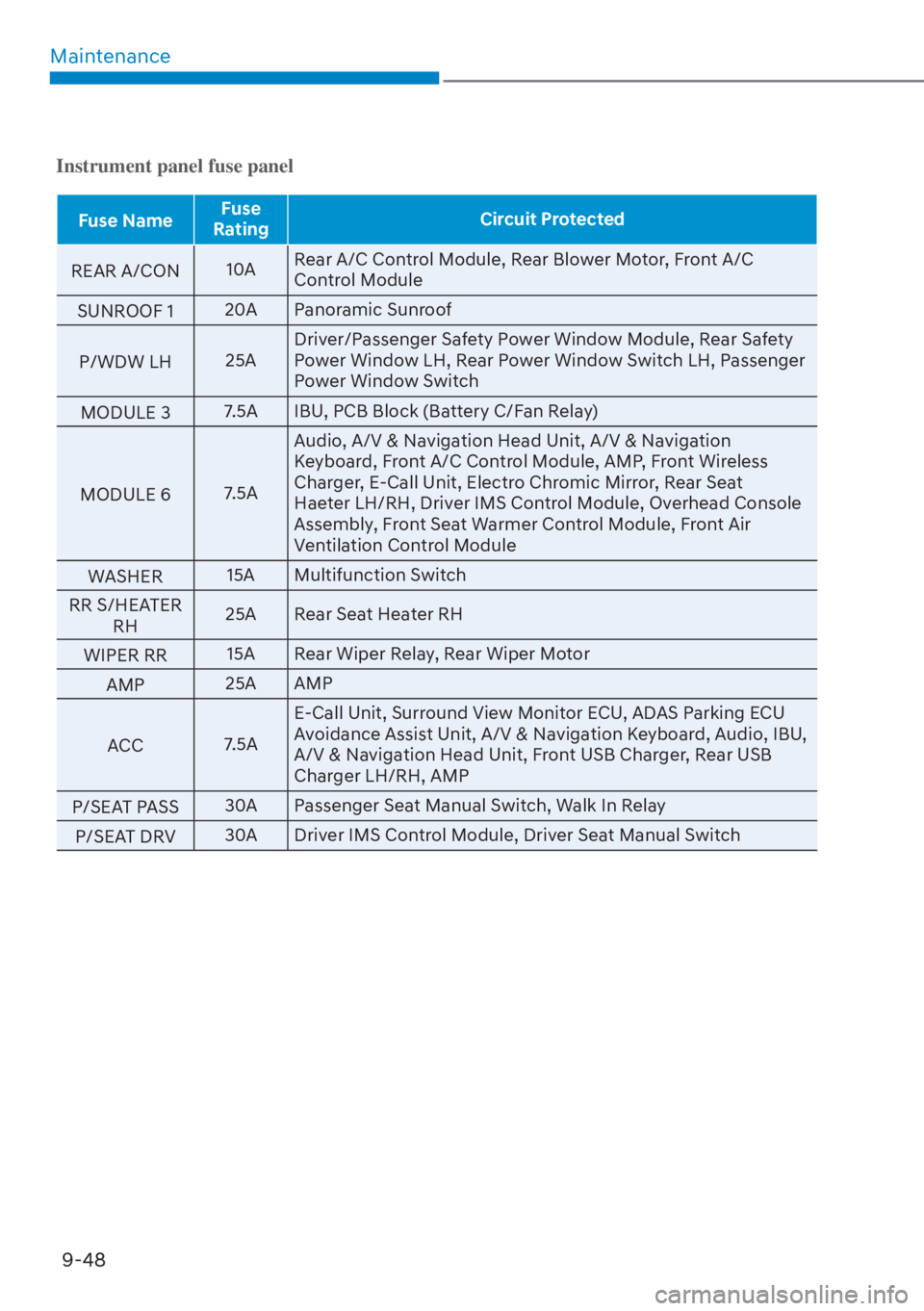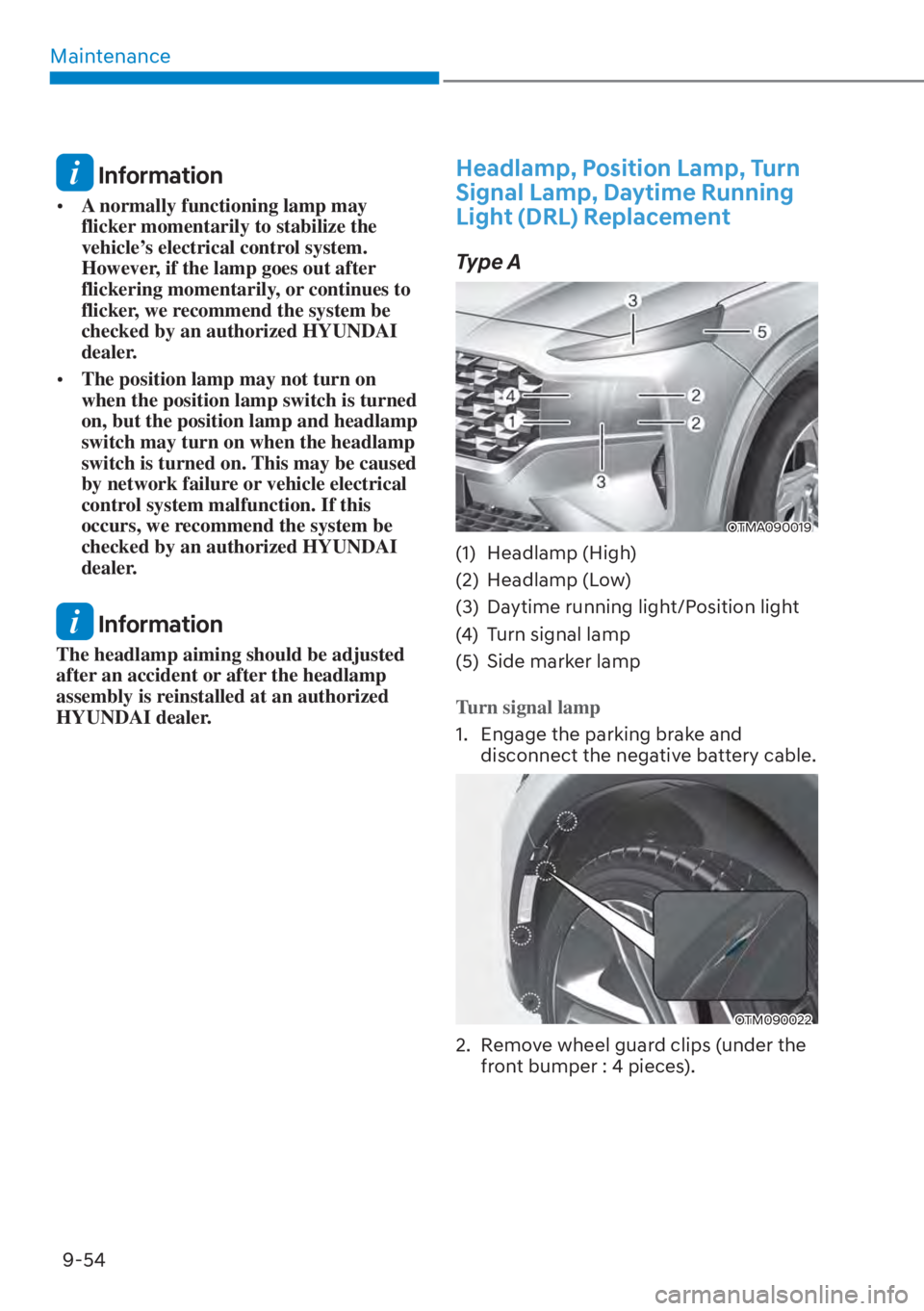Page 576 of 623

Maintenance9-40
Tread wear
The tread wear grade is a
comparative rating based on the
wear rate of the tire when tested
under controlled conditions on a
specified government test course.
For example, a tire graded 150 would
wear one-and-a-half times (1½) as
well on the government course as a
tire graded 100.
The relative performance of tires
depends upon the actual conditions
of their use, however, and may
depart significantly from the norm
due to variations in driving habits,
service practices and differences in
road characteristics and climate.
These grades are molded on the
sidewalls of passenger vehicle tires.
The tires available as standard or
optional equipment on your vehicle
may vary with respect to grade.
Traction - AA, A, B & C
The traction grades, from highest
to lowest, are AA, A, B and C. Those
grades represent the tire’s ability to
stop on wet pavement as measured
under controlled conditions on
specified government test surfaces
of asphalt and concrete. A tire
marked C may have poor traction
performance.
WARNING
The traction grade assigned to
this tire is based on straightahead
braking traction tests, and does not
include acceleration, cornering,
hydroplaning, or peak traction
characteristics.
Temperature - A, B & C
The temperature grades are A (the
highest), B and C representing the
tire’s resistance to the generation
of heat and its ability to dissipate
heat when tested under controlled
conditions on a specified indoor
laboratory test wheel.
Sustained high temperature can
cause the material of the tire to
degenerate and reduce tire life,
and excessive temperature can
lead to sudden tire failure. Grades
B and A represent higher levels of
performance on the laboratory test
wheel than the minimum required
by law.
WARNING
The temperature grade for this
tire is established for a tire that
is properly inflated and not
overloaded. Excessive speed,
under-inflation, over-inflation, or
excessive loading, either separately
or in combination, can cause heat
build-up and possible sudden
tire failure. This may cause loss
of vehicle control resulting in an
accident.
Page 578 of 623

Maintenance9-42
�v Blade type
�v Cartridge type
�v Multi fuse Normal Blown
Normal Blown
Normal Blown
OTM078035
A vehicle’s electrical system is protected
from electrical overload damage by
fuses.
This vehicle has 2 (or 3) fuse panels, one
located in the driver’s side panel bolster,
the other in the engine compartment.
If any of your vehicle’s lights,
accessories, or controls do not work,
check the appropriate circuit fuse. If a
fuse has blown, the element inside the
fuse will be melted or broken.
If the electrical system does not work,
first check the driver’s side fuse panel.
Before replacing a blown fuse, turn the
engine and all switches off, and then
disconnect the negative battery cable.
Always replace a blown fuse with one of
the same rating.
If the replacement fuse blows, this
indicates an electrical problem.
Avoid using the system involved. We
recommend that you immediately
consult an authorized HYUNDAI dealer.
Information
Three kinds of fuses are used: blade type
for lower amperage rating, cartridge
type, and multi fuse for higher amperage
ratings.
FUSES
Page 580 of 623
Maintenance9-44
Engine Compartment Panel Fuse
Replacement
���„Blade type fuse
OTMH090015
���„Cartridge type fuse
OTMH090016
1. Turn the vehicle off.
2. Turn all other switches off.
3. Remove the fuse panel cover by pressing the tap and pulling up.
4. Check the removed fuse; replace it if it is blown. To remove or insert the
fuse, use the fuse puller in the engine
compartment fuse panel.
5. Push in a new fuse of the same rating, and make sure it fits tightly in the
clips. If it fits loosely, we recommend
that you consult an authorized
HYUNDAI dealer.
NOTICE
After checking the fuse panel in the
engine compartment, securely
install the fuse panel cover. You may
hear a clicking sound if the cover is
securely latched. If it is not securely
latched, electrical failure may occur
from water contact.
Multi fuse
OTMH090017
If the multi fuse is blown, we recommend
that you consult an authorized HYUNDAI
dealer.
Page 582 of 623

Maintenance9-46
Instrument panel fuse panel
Fuse Name Fuse
Rating Circuit Protected
MODULE 4 7
.5A Stop Lamp Switch, Data Link Connector, Driver Door Area Unit
AIR BAG 1 15A SRS Control Module
BRAKE
SWITCH 7.5A IBU, Stop Lamp Switch
MODULE 9 15AAudio, A/V & Navigation Head Unit, Instrument Cluster, Front
A/C Control Module, Head-Up Display, Rear Occupant Alert
(ROA) Sensor, Driver IMS Control Module, Power Tail Gate
Unit, Driver Door Area Unit, Rear A/C Control Module,Driver/
Passenger Power Outside Mirror
MODULE 10 10A Rear Corner Radar LH/RH, Front Wireless Charger, VESS UNIT
MODULE 7 10A Head Lamp LH/RH
BATTERY
MANAGEMENT7.5A BMS Control Module
AIR BAG IND. 10A Instrument Cluster, Overhead Console Assembly
IBU 1 7.5A IBU
MODULE 2 7.5AAC Inverter Outlet, AC Inverter Module, Rear Seat Heater LH/
RH, Front Seat Warmer Control Module, Front Air Ventilation
Control Module
MODULE 8 7.5ADriver/Passenger Smart Key Outside Handle, Hazard Switch,
Driver/Passenger Power Outside Mirror, Data Link Connector,
Rain Sensor, UIP Sensor Mood Lamp Unit, Mood Lamp, Mood
Lamp #1/#2
S/HEATER FRT 20AFront Air Ventilation Control Module, Front Seat Warmer
Control Module
Page 584 of 623

Maintenance9-48
Instrument panel fuse panel
Fuse Name Fuse
Rating Circuit Protected
REAR A/CON 10
ARear A/C Control Module, Rear Blower Motor, Front A/C
Control Module
SUNROOF 1 20A Panoramic Sunroof
P/WDW LH 25ADriver/Passenger Safety Power Window Module, Rear Safety
Power Window LH, Rear Power Window Switch LH, Passenger
Power Window Switch
MODULE 3 7.5A IBU, PCB Block (Battery C/Fan Relay)
MODULE 6 7.5AAudio, A/V & Navigation Head Unit, A/V & Navigation
Keyboard, Front A/C Control Module, AMP, Front Wireless
Charger, E-Call Unit, Electro Chromic Mirror, Rear Seat
Haeter LH/RH, Driver IMS Control Module, Overhead Console
Assembly, Front Seat Warmer Control Module, Front Air
Ventilation Control Module
WASHER 15A Multifunction Switch
RR S/HEATER RH 25A Rear Seat Heater RH
WIPER RR 15A Rear Wiper Relay, Rear Wiper Motor
AMP 25A AMP
ACC 7.5AE-Call Unit, Surround View Monitor ECU, ADAS Parking ECU
Avoidance Assist Unit, A/V & Navigation Keyboard, Audio, IBU,
A/V & Navigation Head Unit, Front USB Charger, Rear USB
Charger LH/RH, AMP
P/SEAT PASS 30A Passenger Seat Manual Switch, Walk In Relay
P/SEAT DRV 30A Driver IMS Control Module, Driver Seat Manual Switch
Page 586 of 623
Maintenance9-50
Engine compartment fuse panel
Type Fuse Name Fuse
Rating Circuit Protected
MULTI
FUSE 1 (10P) C/F
AN 1
80A Cooling Fan Controller
B+4 50AICU Junction Block (Fuse – F16/F17/F26/F27/F36/
F46)
B+2 50AICU Junction Block (IPS 8 SPOC+/IPS 11/IPS 13/IPS
14/IPS 15)
B+3 50AICU Junction Block (Fuse – F19/F29/F38/F39/F48/
F49)
IEB 1 40A IEB Unit
BLOWER 40A RLY. 9 (Blower Relay)
IG2 40A PCB Block (IG2 Relay)
ABS 30A Not Used
MULTI
FUSE 2 (10P) MDPS *
1100A MDPS Unit
IEB 2 60A IEB Unit
B+6 60A PCB Block (B+)
CVVD 50A CVVD Actuator
RR HTD1 40A RLY. 1 (Rear Heated Relay)
INVERTER 40A AC Inverter Module
E-SHIFTER 1 40A SCU
*1 : MDPS (Motor Driven Power Steering) is the same as EPS (Electric Power Steering)
Page 588 of 623
Maintenance9-52
Engine compartment fuse panel
Fuse Name Fuse
Rating Circuit Protected
IG1 40
A IG1 Relay
TCU2 10A TCM
SENSOR3 20A ECM, Oxygen Sensor (Up/Down)
SENSOR1 10A ELCM
EWP2 10A Electronic Water Pump
ECU3 10A ECM, CVVD Actuator
SENSOR6 10A OPU
POWER
OUTLET1 20A Luggage Power Outlet
WIPER2 10A IBU, Front Wiper Motor
HORN 15A Horn Relay
IEB4 10A IEB Unit
SENSOR2 10APurge Control Solenoid Valve,
Oil Control Valve #1/#2(Intake/Exhaust),
Oil Pump Solenoid Valve, Cooling Fan Motor,
RCV Control Solenoid Valve
SENSOR4 15A Active Purge Pump
SENSOR5 10A E/R Junction Block (RLY. 5)
IGN COIL 20A Ignition Coil #1/#2/#3/#4
ACC 20A ICU Junction Block (Fuse – F37/F47)
POWER
OUTLET2 20A Front Power Outlet
WIPER1 30A Front Wiper Motor, Front Wiper (Low) Relay
E-SHIFTER3 10A SCU
FCA 10A Front Radar Unit
HPCU 2 10A HPCU
ECU1 15A ECM
ECU4 20A ECM
TCU1 15A TCM
RR HTD2 10A E/R Junction Block (RLY. 1)
Page 590 of 623

Maintenance9-54
Information
�[�� A normally functioning lamp may
flicker momentarily to stabilize the
vehicle’s electrical control system.
However, if the lamp goes out after
flickering momentarily, or continues to
flicker, we recommend the system be
checked by an authorized HYUNDAI
dealer.
�[�� The position lamp may not turn on
when the position lamp switch is turned
on, but the position lamp and headlamp
switch may turn on when the headlamp
switch is turned on. This may be caused
by network failure or vehicle electrical
control system malfunction. If this
occurs, we recommend the system be
checked by an authorized HYUNDAI
dealer.
Information
The headlamp aiming should be adjusted
after an accident or after the headlamp
assembly is reinstalled at an authorized
HYUNDAI dealer.
Headlamp, Position Lamp, Turn
Signal Lamp, Daytime Running
Light (DRL) Replacement
Type A
OTMA090019
(1) Headlamp (High)
(2) Headlamp (Low)
(3) Daytime running light/Position light
(4) Turn signal lamp
(5) Side marker lamp
Turn signal lamp
1. Engage the parking brake and
disconnect the nega
tive battery cable.
OTM090022
2. Remove wheel guard clips (under the front bumper : 4 pieces).